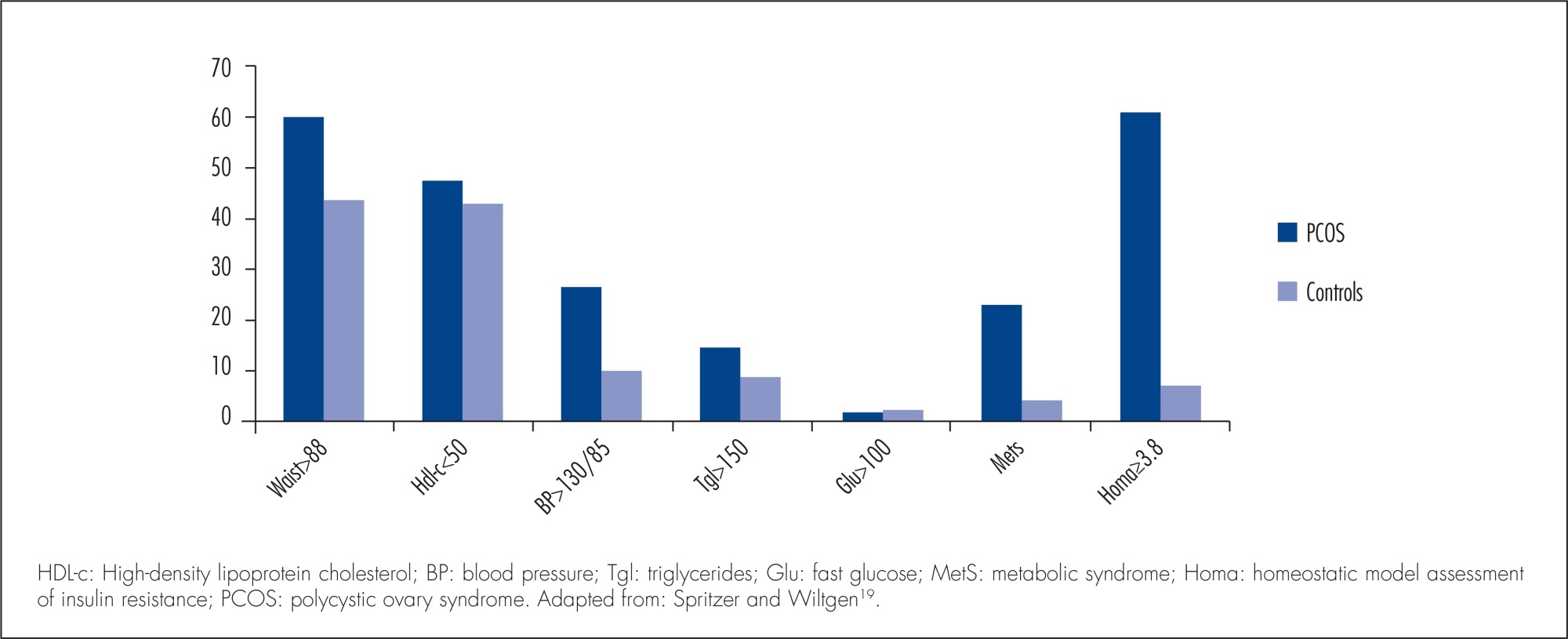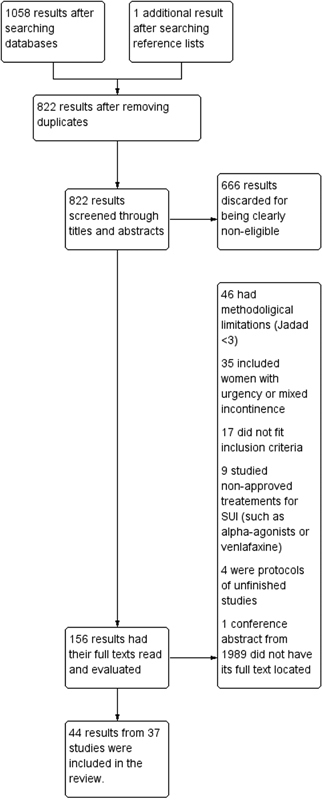-
07-23-2000
A FEBRASGO e o Novo Ano
Revista Brasileira de Ginecologia e Obstetrícia. 2000;22(10):607-607
-
Original Article07-23-2000
3beta-Hydroxysteroid Dehydrogenase and 21-Hidroxylase Enzymatic Activities in Hirsute Women with and without Chronic Anovulation
Revista Brasileira de Ginecologia e Obstetrícia. 2000;22(9):585-591
Abstract
Original Article3beta-Hydroxysteroid Dehydrogenase and 21-Hidroxylase Enzymatic Activities in Hirsute Women with and without Chronic Anovulation
Revista Brasileira de Ginecologia e Obstetrícia. 2000;22(9):585-591
DOI 10.1590/S0100-72032000000900008
Views142See morePurpose: to test the adrenal function by a potent stimulus to its reticular layer verifying 3beta-hydroxysteroid dehy-drogenase (3beta-HSD) and 21-hydroxylase (21OH) enzymatic activities. Methods: plasma concentrations of 17alphaOH-pregneno-lone, 17alphaOH-progesterone, cortisol, progesterone, androstenedione, dehydroepiandrosterone (DHEA), dehydroepiandrosterone sulfate (SDHEA) and free testosterone were determined in 39 women, 13 of whom were normal (2 of them used in a pilot study) and 26 had idiopathic hirsutism, 0, 12 and 24 h after injection of ACTH-depot. Results: among hirsute women, we identified different responses that could diagnose any blockage in the steroid pathways leading to the diagnosis of a mild/moderate decreased adrenal function. The 17alphaOH-pregnenolone concentrations varied from 2.0 to 24.6 ng/mL, cortisol values increased from 2.1 to 45.3 and 38.4 mug/dL, 17alphaOH-progesterone levels varied from 50.7 to 346 and 218 ng/mL and progesterone increased from 0.3 to 4.4 and 2.2 ng/mL. Among the reticular layer hormones a rise of SDHEA from 274.7 to 495.5 and 505.8 mg/dL, and of androsterone from 1.1 to 4.0 and 4.5 ng/mL was observed, the levels of free testosterone increased from 1.3 to 1.8 and 2.7 pg/mL and the DHEA levels from 2.4 to 4.7 and 8.5 ng/mL. One patient showed 3beta-HSD deficiency and two others a possible 21OH deficiency. Conclusions: these findings suggest that the ACTH-depot test could be used to exclude the adrenal gland as the possible source of hyperandrogenism in women with idiopathic hirsutism.
-
Original Article07-23-2000
Frequency of Cervical Intraepithelial Neoplasia in Human Immunodeficiency Virus-infected Women
Revista Brasileira de Ginecologia e Obstetrícia. 2000;22(9):573-577
Abstract
Original ArticleFrequency of Cervical Intraepithelial Neoplasia in Human Immunodeficiency Virus-infected Women
Revista Brasileira de Ginecologia e Obstetrícia. 2000;22(9):573-577
DOI 10.1590/S0100-72032000000900006
Views179See morePurpose: to verify the frequency of cervical intraepithelial neoplasia in human immunodeficiency virus (HIV) ¾ infected women. Methods: ninety-nine HIV-seropositive women were studied. The diagnosis of the HIV infection was established through two ELISA tests complemented by Western blot test or indirect immunofluorescence test. As control group, 104 women whose ELISA test was not positive were analyzed. The investigation of cervical intraepithelial neoplasia was achieved by association of Pap smear and colposcopy in both groups. In the cases where colposcopy revealed existence of abnormal transformation zones, NIC diagnosis was obtained through colposcopy-guided biopsy complemented or not by conization. Results: cervical intraepithelial neoplasia was found in 15 of the 99 patients (15.2%), and among them there were ten NIC I, one NIC II and four NIC III. Among the 104 women of the control group, four presented cervical intraepithelial neoplasia (3.8%), one being NIC I and three NIC III. Conclusion: the comparative analysis of the results showed that the frequency of cervical intraepithelial neoplasia was significantly higher among those patients infected with HIV.
-
Original Article07-23-2000
Experimental Arterial Hypertension and Pregnancy in Rats: Repercussion Regarding Body Weight Gain, Body Length and Organs of Offspring
Revista Brasileira de Ginecologia e Obstetrícia. 2000;22(9):567-572
Abstract
Original ArticleExperimental Arterial Hypertension and Pregnancy in Rats: Repercussion Regarding Body Weight Gain, Body Length and Organs of Offspring
Revista Brasileira de Ginecologia e Obstetrícia. 2000;22(9):567-572
DOI 10.1590/S0100-72032000000900005
Views122Purpose: to study the repercussion of arterial hypertension regarding body weight gain and body length, as well as liver and brain weight of offspring. Methods: a total of 82 animals in reproductive age were used. They were randomly assigned to 4 different groups (control, handled, nephrectomized and hypertensive). Renal hypertension was produced by a controlled constriction of the main left renal artery and contralateral nephrectomy, according to the technique described by Goldblatt (Goldblatt I: one kidney – one clip hypertension). Afterwards, they were distributed among nonpregnant and pregnant groups. The following newborn groups resulted from the pregnant groups: RN-C (control-newborn group of pregnant rats without surgical treatment), RN-M (manipulation-newborn group of the pregnant rats with surgical manipulation), RN-N (nephrectomized-newborn group of pregnant rats with nephrectomy) and Rn-H (hypertensive-newborn group of pregnant rats with hypertension). Results: the RN-N and RN-H groups showed body weight gain (
 = 3,64 ± 0,50;
= 3,64 ± 0,50;  or = 3,37 ± 0,44), body length (
or = 3,37 ± 0,44), body length ( = 3,89 ± 0,36;
= 3,89 ± 0,36;  or = 3,68 ± 0,32) and brain weight (
or = 3,68 ± 0,32) and brain weight ( = 0,16 ± 0,01;
= 0,16 ± 0,01;  or = 0,16 ± 0,05), respectively, smaller than the control group (
or = 0,16 ± 0,05), respectively, smaller than the control group ( = 5,40 ± 0,51;
= 5,40 ± 0,51;  or = 4,95 ± 0,23 and
or = 4,95 ± 0,23 and  or = 0,22 ± 0,04, respectively). In addition, the RN-H group showed the lowest liver weight (
or = 0,22 ± 0,04, respectively). In addition, the RN-H group showed the lowest liver weight ( = 0,22 ± 0,03) compared with the other three groups. Conclusion: after statistical analysis, the results obtained showed that the arterial hypertension determined a reduction in body weight, body length, and liver and brain weight of the offspring.Key-words Experimental hypertension in ratsHypertension and pregnancyIntrauterine growth retardationSee more
= 0,22 ± 0,03) compared with the other three groups. Conclusion: after statistical analysis, the results obtained showed that the arterial hypertension determined a reduction in body weight, body length, and liver and brain weight of the offspring.Key-words Experimental hypertension in ratsHypertension and pregnancyIntrauterine growth retardationSee more -
Original Article07-23-2000
Fetal Surveillance in Pregnancies Complicated by Diabetes: Analysis of Neonatal Outcome
Revista Brasileira de Ginecologia e Obstetrícia. 2000;22(9):557-566
Abstract
Original ArticleFetal Surveillance in Pregnancies Complicated by Diabetes: Analysis of Neonatal Outcome
Revista Brasileira de Ginecologia e Obstetrícia. 2000;22(9):557-566
DOI 10.1590/S0100-72032000000900004
Views121Purpose: to study the fetal well-being assessment in pregnancies complicated by diabetes, and to analyze the neonatal results. Methods: we studied 387 pregnant women with diabetes at the Fetal Surveillance Unit. The last examination (cardiotocography, fetal biophysical profile, amniotic fluid index and dopplervelocimetry) was correlated with the neonatal outcome. Results: the studied population included 46 (12%) type I diabetes, 45 (12%) type II and 296 (76%) gestational diabetes. Type I diabetes with abnormal or suspected cardiotocography was related to abnormal 1st minute Apgar (50 and 75%, p<0.05) and to the need for neonatal intensive care unit (50 and 75%, p<0.05). The abnormal biophysical profile in type II diabetic pregnancy was related to the need for neonatal intensive care (67%, p<0.05), and abnormal umbilical artery Doppler study was related to abnormal 1st minute Apgar (67%, p<0.05). Gestational diabetes with abnormal cardiotocography presented 36% abnormal 1st minute Apgar (p<0.05), 18% abnormal 5th minute Apgar (p<0.01) and 18% neonatal death (p<0.01). Abnormal amniotic fluid index was related to abnormal 5th minute Apgar (p<0.05) and need for neonatal intensive care unit (p<0.05). Gestational diabetes with abnormal umbilical artery Doppler was related (p<0.05) to: abnormal 1st and 5th minute Apgar, respectively, 25 and 8%, Need for neonatal intensive care in 17% and neonatal death in 8%. Conclusions: the fetal well-being examinations correlated with adverse perinatal outcome, showing the need for fetal surveillance in diabetic pregnant women.
Key-words Amniotic fluid indexCardiotocographyDiabetes mellitusDopplervelocimetryFetal biophysical profileSee more -
Original Article07-23-2000
Assessment of Embryo Heart Rate in Early Pregnancy by Transvaginal Ultrasonography with Color and Pulsed Doppler
Revista Brasileira de Ginecologia e Obstetrícia. 2000;22(9):551-555
Abstract
Original ArticleAssessment of Embryo Heart Rate in Early Pregnancy by Transvaginal Ultrasonography with Color and Pulsed Doppler
Revista Brasileira de Ginecologia e Obstetrícia. 2000;22(9):551-555
DOI 10.1590/S0100-72032000000900003
Views138See morePurpose: to evaluate the evolution in the embryo heart rate in the first trimester of pregnancy. Patients and Methods: in a prospective study 206 pregnant women were evaluated in the first trimester of pregnancy, by transvaginal color Doppler sonography, using Aloka, SSD-2000 apparatus, with a 5-MHz transvaginal transducer. All examinations were performed by the same examiner, with the determination of embryo heart rate. The patients were classified into groups according to the gestational age, in half-week intervals from the 5th week of pregnancy on. Pregnancy outcome was evaluated by ultrasonography at the end of second and third trimesters. Mean and standard deviation were determined for each evaluated gestational age. Results: it was possible to determine normal values for embryo heart rate. Mean embryo heart rate showed changes with gestational age, ranging from 110 ± 14 bpm at the 6.0th week to 150 ± 12 bpm at the 14.0th week. Conclusions: transvaginal pulsed color Doppler equipment enabled cardiovascular evaluation in early pregnancy, being a noninvasive method and innocuous to the embryo. These values would be useful in new studies on dopplervelocimetry in this period of pregnancy.
-
07-23-2000
FEBRASGO e a Humanização do Parto Uma Homenagem a Galba de Araújo
Revista Brasileira de Ginecologia e Obstetrícia. 2000;22(8):473-473
-
07-11-2000
Estudo de Alguns Fatores de Risco para a Presença de Mecônio no Líquido Amniótico
Revista Brasileira de Ginecologia e Obstetrícia. 2000;22(8):530-530
Abstract
Estudo de Alguns Fatores de Risco para a Presença de Mecônio no Líquido Amniótico
Revista Brasileira de Ginecologia e Obstetrícia. 2000;22(8):530-530
DOI 10.1590/S0100-72032000000800012
Views53Estudo de Alguns Fatores de Risco para a Presença de Mecônio no Líquido Amniótico […]See more
Search
Search in:
Tag Cloud
Pregnancy (252)Breast neoplasms (104)Pregnancy complications (104)Risk factors (103)Menopause (88)Ultrasonography (83)Cesarean section (78)Prenatal care (71)Endometriosis (70)Obesity (61)Infertility (57)Quality of life (55)prenatal diagnosis (51)Women's health (48)Maternal mortality (46)Postpartum period (46)Pregnant women (45)Breast (44)Prevalence (43)Uterine cervical neoplasms (43)






